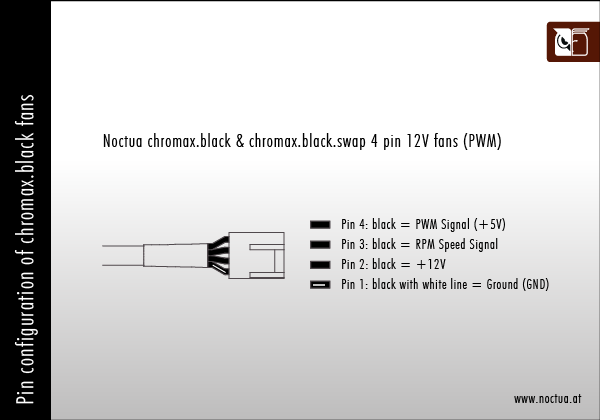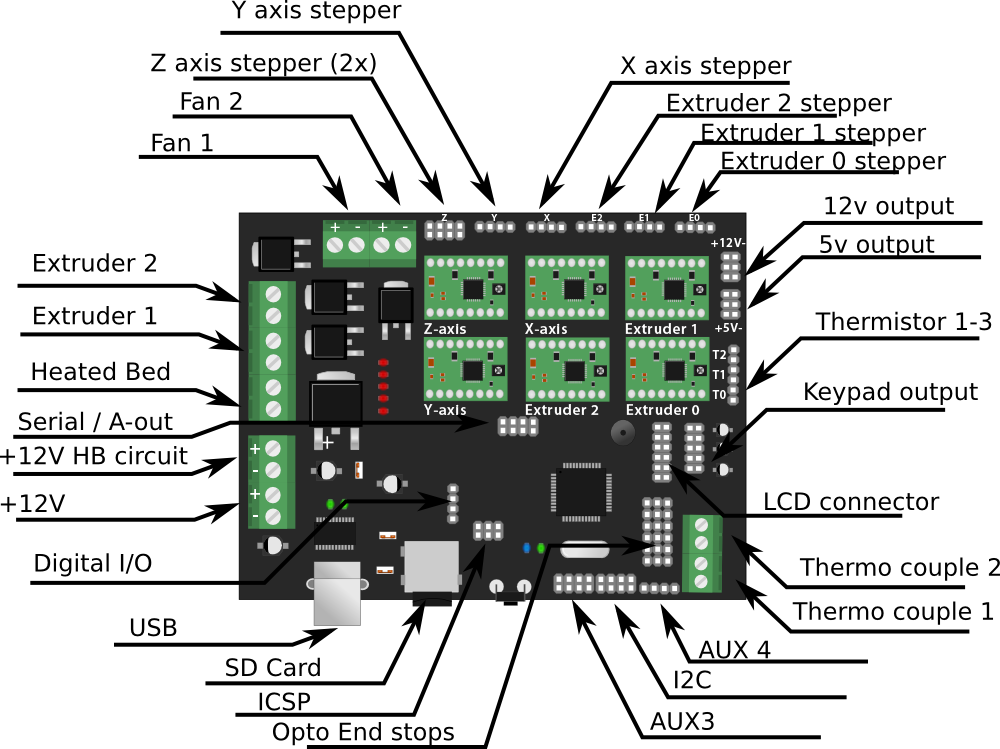

The RPM output seems to be an open collector, which requires a proper pull up on the RPi to ensure it's only pulled up to 33V (and not higher), wihtout pulling too much current from the Noctua (addressed in the Noctua white paper) HP PWM 4-wire fan pinout is always ground, 12vdc, rpm sense, pwm control for pins1 to 4, and there may be a ground jumper from pin 1 to pin 5 to tell the motherboard the fan is part of a 'Performance' heatsink/fan. Which means it can, under certain condiitons, damage the gpio pin if you are lucky, burn the CPU if unlucky, Cna be addressed with a proper voltage divider and/or a logic level shifter like which should work, but would need to take some measurements on the Noctua to be sure That is likely to create voltage spikes above 3.3V on the GPIO pin used to create the PWM signal. The Noctua seems to have a weak pull up to 5V on the PWM input. Phanteks Y splitter can also be used with other 4-pin fan as well, maximizing the amount of fans you can have in your build.

Put the VCC in into the 5v pin on the Pi and the GND pin into the ground on the Pi and then choose any GPIO pin for the PWM signal.

It might work still and I don't think you'll do damage to the fan or your pi if it doesn't. Power supply is in standby mode.I don't mean to sound offensive, but if a person doesn't understand open collector outputs, pull up resistors and voltage dividers, they should not provide advice. The Y-Splitter allows you to connect 2 fans to each fan header. Looking at the spec it asks for the PWM pin to be +5v but the RPi GPIO outputs 3.3v. PSON activated by pressing and releasing the power button while the In this video, I show off the Gamerstorm (Deepcool) RGB Converter, a product that converts a 5v ARGB signal to a 12v signal, allowing you to connect ARGB pro. This makes the configuration of the RGB header quite simple as it takes individual signals of the three colors and combines them to produce an effect. There is a ground pin, and then individual pins for the colors Red, Green, and Blue. The header itself is a 12V header that has 4 pins. if that works you can forget about the +5V Thats how normal fan headers are wired: The 4th pin on 4 pin headers is a PWM (pulse with modulation) signal, which allows changing the fan speed without the need to lower the voltage on the +Vcc line. 4 pin single row female connector Pinout status: +67 -3 According to 70 reports in our database ( 67 positive and 3 negative) the Dell 5 pin Fan connector to standard 4 pin PWM Fan pinout should be correct. Pinout The pinout for the RGB header is quite simple. With older AT class expansion cards and can be omitted on newer units) Test if the fans spin up if you connect +12V and GND (neutral). 5 VDC (this is optional on newer ATX-2 supplies, it is for use Short this pin to GND to switch power supply ON, disconnect from GND to switch OFF. +5 VDC Standby Voltage (max 10mA, max 2A in ATX 2.2 spec) Required for proper computer operation (+5 VDC when power is Ok) The computer that the DC operating voltages are within the ranges

If you'd like your fan to only run when needed (based on Pi temperature), check out our Raspberry Pi fan controller guide. The fan should receive power automatically when the Pi is booted. Power Ok is a status signal generated by the power supply to notify Connect the fan's red wire to GPIO pin 4 (5V) and the black wire to GPIO pin 6 (ground). New ATX v 2.2 uses new connector, but most motherboards nowdays allow to use an old ATX v 1.x power supply with ATX 20 pin connector - it connects to 24 pin motherboard receptacle. That two independent 12 V rails (12 V2 for the 4 pin connector and 12 V1įor everything else) with independent overcurrent protection are needed Most power is now provided on 12 V rails and the power onģ.3 V and 5 V rails was significantly reduced. Changes to ATX standard were made to support 75 watt PCI Express


 0 kommentar(er)
0 kommentar(er)
